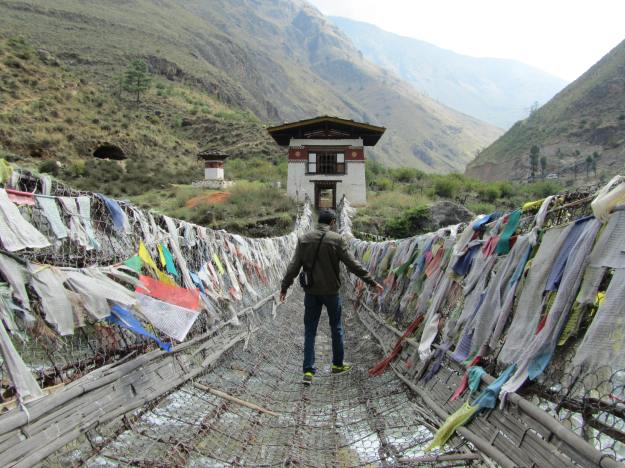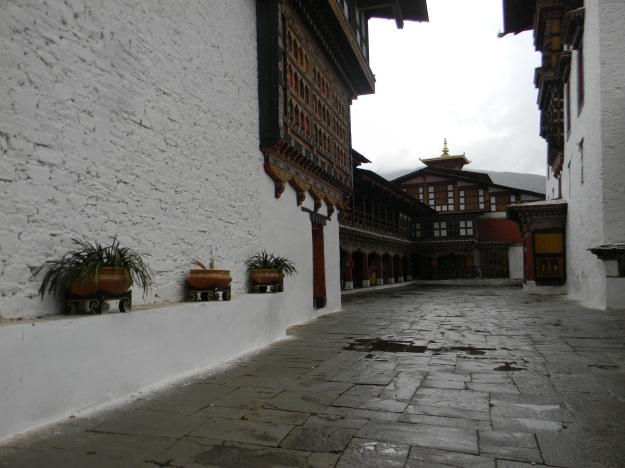We went to Paro after getting our permit done in Phuentsholing. Phuentsholing is the border town and there’s just one gate that separates India and Bhutan. The drive from Phunetholing to Paro is scenic, pretty much like any other drive in Bhutan. It’s a winding road lined with ferns everywhere, and you see densely green mountains as far as your vision reaches. Plus, there is a bonus of waterfalls thrown in everywhere.
Paro is a fairly small town, entirely walk-able. The main street is lined with general and handicraft shops. The town has an old world charm with little traditional eateries along the paved footpath. The cars are lined neatly on either side of the road. The entry to the town is beautiful with a lovely wooden bridge on the side of the road, the Paro Chhu river flowing alongside the town, and a very scenic airport right at the entrance. You’ll see several apple trees in the backyards of even the smallest of houses, not just in Paro, but all of Bhutan.
I’m listing the places we visited in Paro in no particular order.
Taktsang (Tiger’s Nest) Monastery
This has got to be the high point of our Bhutan trip. That’s at least what we kept feeling all the way up the fairly tough and steep hike to the monastery. it’s probably a 4 km walk uphill, and the entire path is lined with prayer flags. The views of the mountain and the valleys are breathtaking.
I could take a hundred picture at every step had I had two days to climb up to the point. The monastery is built at the very edge of the rocky mountain and you can’t help wondering at how it was even built. You have got to give it to the monks…they sure know how to find the best places for their meditation. Climbing up is an unreal and awakening experience. I don’t mean in terms of spiritual awakening, but it terms of how unique it is, and oh so rewarding. As you keep climbing up the mountain, the monastery starts appearing clearer. At some points it’s covered in fog and looks like a magical vision playing peek-a-boo.
Chelela Pass
Chelela is a high-altitude spot about two-hour drive from Paro. The road is a narrow, winding one and passes through a village called Bondey. Once you cross the village, the number of people and houses starts getting sparser. Then all you see is beautiful road cut through the mountain, and at every turn the valley getting deeper. This particular patch has millions of wild purple flowers, and from a distance it looks like a lovely velvet carpet dotted with greens here and there. There are also various shades of yellow flowers on the way.
The Chelela point itself is at an altitude of 3988 metres. It’s very windy there. At the time we reached there, it had started snowing, and we also spotted some areas covered with fresh snow. It was insanely cold, and we were clearly not clothed enough for such weather. But nothing would deter us from roaming around in the chilly winds and snow. We could hardly see anything else due to the fog, but this was a great experience nonetheless.
On our way back, we spotted a couple of Yaks and stopped to take pictures. I was also lucky enough to spot a baby yak. My day was made.
Paro Dzong
Dzongs are basically administrative offices. But because of rthe importance of religion in Bhutanese life, these fortresses generally also have a few temples inside. They typically have a huge courtyard, and then several rooms for various departments like culture, education etc. Paro Dzong didn’t seem special to me, but it’s still an impressive building. Just that once you start noticing that every other dzong you see in better than the first one, this one fades in comparison.
And there is this lovely little temple in one corner, which is my favorite part of the dzong.
National Museum
The national museum at Paro is quite small. What I found interesting is the part about the various teas, that also had ancient tea vessels. If you are short of time, this is something I would skip. The view of Paro from the museum is quite nice though.
Kyichu Lhakhang
Lhakhangs are temples. Kyichu Lhakhang is the oldest temple in Bhutan. For such an important temple, it’s surprisingly understated, which is part of it’s charm. It’s a small temple on the outskirts of Paro.
There’s an orange tree within the temple premise, which apparently bears fruit throughout the year. The temple is lined with prayer wheels all around. It’s a very nice and peaceful spot to end your day with.
Tachog Lhakhang
This is an old Tibetan temple on the outskirts of Paro. You can spot it from a distance on the road between Paro and Thimphu. It’s on the top of a small hill, and you need to climb down the road, cross the foot bridge to get to the other side, and then hike up the hill again.
The bridge is sturdy but a little scary as you can see running water under you as you walk. This made be a little dizzy, so I took the smaller wooden bridge instead. The husband easily managed to iron mesh bridge though.
 This bridge is of great significance to the Tibetan Buddhists. The temple itself is built in honor of Thang Tong Gyalpo, the Buddhist yogi who is said to have built several iron chain bridges across Bhutan and Tibet. He is believed to have molded iron chains himself. The temple has a huge chain. We were told by the monk there that the Gyalpo himself had created it. We are not religious, but we did quite enjoy the stories, We also spoke quite a bit to a small group of Tibetan Nepalese who were on a pilgrimage to Bhutan and had come specially to visit the temple. The woman in the group kept offering money at various spots in the temple: the place where the Gyalpo used to sit, the iron chain he made, the walking stick he used, the shrine itself, the religious scriptures etc. By the time I stopped counting, she had already offered about a thousand Rupees.
This bridge is of great significance to the Tibetan Buddhists. The temple itself is built in honor of Thang Tong Gyalpo, the Buddhist yogi who is said to have built several iron chain bridges across Bhutan and Tibet. He is believed to have molded iron chains himself. The temple has a huge chain. We were told by the monk there that the Gyalpo himself had created it. We are not religious, but we did quite enjoy the stories, We also spoke quite a bit to a small group of Tibetan Nepalese who were on a pilgrimage to Bhutan and had come specially to visit the temple. The woman in the group kept offering money at various spots in the temple: the place where the Gyalpo used to sit, the iron chain he made, the walking stick he used, the shrine itself, the religious scriptures etc. By the time I stopped counting, she had already offered about a thousand Rupees.
You can’t help wondering about how religions evolve into ceremonies and practices that go quite against the basic premise of any religion. Idol worship in this case, and also some degree of superstition. On our way back we were crossing one of the smaller stupas, when the lady asked us to go to the other side, as the temple should always be on your right. I understand that this is about religious belief. But shouldn’t your belief make you stronger and fearless, instead of bogging you down and reducing great philosophies to just a protocol? Respect surely doesn’t reflect in which side of the road you take, but it’s something at a far deeper and personal level. Something to think about…










